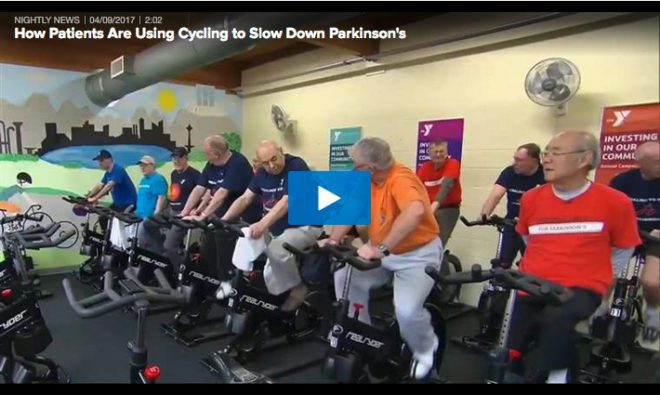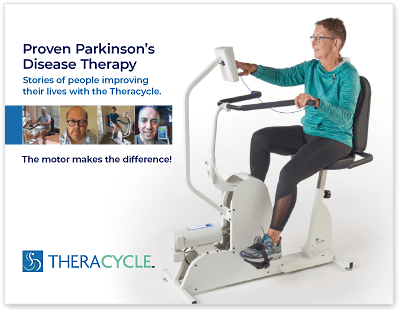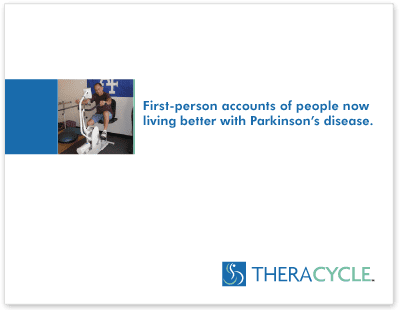- ›
- Why Theracycle ›
- Research and Studies ›
- Parkinson’s Therapy Research: Tandem Bike Inspiration
Research and Studies
Parkinson’s Therapy Research: Tandem Bike Inspiration

Background: Tandem Bike Inspiration
A research study using forced exercise as a Parkinson’s disease therapy treatment has been undertaken by Cleveland Clinic biomedical engineer, Jay Alberts, PhD. During a 200-mile group bicycle trip across Iowa in 2003, Dr. Alberts pedaled the lead position on a tandem bicycle with a woman that has Parkinson’s disease. Normally the doctor’s friend would pedal at a speed of 50–60 repetitions per minute, however during this trip she was forced to pedal at a rate of 80–90 RPM with Dr. Alberts. Before the ride, the Parkinson’s patient was suffering from hand tremors. As the two pedaled throughout the day, the woman noticed her tremor went away while she was pedaling on the tandem bicycle.
Inspired by her improved motor functions, Dr. Alberts undertook another forced exercise experiment with a different patient. In 2006, Dr. Alberts took the lead again on a tandem bike with a Parkinson’s disease patient that depended on a surgically implanted device to control his symptoms. The patient bicycled 50 miles with the device turned off. As a result of their tandem bike ride, the patient did not experience any Parkinson’s disease symptoms.
Motivated by his observations and knowledge of past animal studies, Dr. Alberts set out to test his theories of forced exercise as a Parkinson’s disease therapy treatment.
Initial Study: Forced Exercise vs. Voluntary Exercise for Parkinson’s
The original research ‘Proof of Concept Pilot’ study began with ten participants with Parkinson’s Disease symptoms. Dr. Alberts separated the patients into two groups. During an eight-week period, all participants were required to partake in one-hour sessions, three days a week on either a tandem bicycle with forced exercise or a stationary bicycle using voluntary exercise. Patients in the forced exercise group exercised with a trainer on a stationary tandem bike at a pedal speed of 80–90 RPM. Parkinson’s disease patients in the voluntary exercise group were encouraged to pedal at their own pace on a stationary bike during their exercise therapy sessions.
Tandem Bike Results:
Parkinson’s patients in the forced exercise group had on average a 30-percent improvement in their symptoms, as opposed to the patients in the voluntary exercise group. Two weeks after the study had ended, patients in the forced exercise group still had about a 20-percent improvement. According to Dr. Alberts, patients with medication typically have slightly less improvement. And with deep brain stimulation, patients have between about 30 and 40 percent improvement, which is about the same. But as he points out, “If you stop taking medication, the disease symptoms come back within a few hours, and these often have side effects. And with deep brain stimulation, you turn the stimulator off and the symptoms come back almost immediately.” He says he’s excited by the fact that the symptomatic improvement from tandem exercise is sustained for weeks. He does add that he doesn’t see tandem exercise as something that would replace deep brain stimulation but instead could be used as an adjunct.
Cleveland Clinic Study: Using the Theracycle exercise bicycle for Parkinson’s disease research
Dr. Alberts chose to use motor-driven bicycles for his follow on VA and NIH funded Parkinson’s disease study involving forced exercise. The Theracycle motorized exercise bicycle has been identified as one of the few exercise devices able to replicate the 80–90 RPM needed for the Cleveland Clinic bike study. Over 150 participants with Parkinson’s disease have been chosen to study the effects of forced exercise on the Theracycle exercise bicycle. Parkinson’s disease research as well as future clinical trials at the Cleveland Clinic will focus on the:
- Duration of improved symptoms
- Effects of forced exercise on biomechanical measures of lower extremity function and postural stability
- Optimal amount of forced exercise
- Mechanism(s) underlying the benefit of forced exercises to voluntary exercises
- Slowing the progression of Parkinson’s disease
Results Parkinson’s Disease Therapy with Forced Exercise:
As of 2009, the Cleveland Clinic Parkinson’s study utilizing Theracycle exercise bikes has concluded. To view the results of this Parkinson’s disease study, please proceed to the Cleveland Clinic – Parkinson’s Bike Study Abstract.







